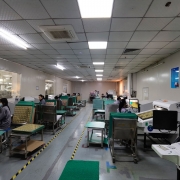Ilustrowana historia obwodów drukowanych
Ilustrowana historia obwodów drukowanych
Pierwsza płytka drukowana (PCB) została opracowana w latach trzydziestych XX wieku przez Paula Eislera, który studiował inżynierię i był redaktorem czasopism, zanim zajął się inżynierią elektryczną. Eisler wpadł na pomysł, że drukowanie na papierze może być wykorzystywane nie tylko w gazetach. Opracował ten pomysł w małym jednopokojowym mieszkaniu w Hampstead w Londynie.
Moe Abramson
Na historię obwodów drukowanych miało wpływ wiele osiągnięć technologicznych. Niektóre z pierwszych obwodów drukowanych zostały stworzone przez Moe Abramsona, inżyniera komputerowego, który pomógł opracować proces automatycznego montażu. Abramson opracował również wzory połączeń folii miedzianej i techniki lutowania zanurzeniowego. Jego proces został później udoskonalony, a jego praca doprowadziła do powstania standardowego procesu produkcji obwodów drukowanych.
Płytka drukowana to obwód, który mechanicznie wspiera i elektrycznie łączy komponenty elektroniczne. Zazwyczaj wykonana jest z dwóch lub więcej warstw arkuszy miedzi. Proces produkcyjny pozwala na większą gęstość komponentów. Posiada również platerowane otwory przelotowe do połączeń elektrycznych. Bardziej zaawansowane płytki PCB zawierają również wbudowane komponenty elektroniczne.
Stanislaus F. Danko
Historia obwodów drukowanych sięga połowy XX wieku. Wcześniej komponenty elektroniczne miały przewody i były lutowane bezpośrednio do ścieżki PCB. Pierwszy proces automatycznego montażu został opracowany przez Moe Abramsona i Stanislausa F. Danko, którzy byli członkami amerykańskiego Korpusu Sygnałowego. Opatentowali oni ten proces i od tego czasu stał się on standardową metodą produkcji płytek drukowanych.
Płytki drukowane są ważną częścią urządzeń elektronicznych. Od swoich skromnych początków w połowie XIX wieku, stały się one powszechne. Ich ewolucja była napędzana przez rosnące wymagania konsumentów. Dzisiejsi konsumenci oczekują natychmiastowej reakcji od swoich urządzeń elektronicznych. W 1925 roku Charles Ducas opracował proces zwany "drukowanym drutem", aby zmniejszyć złożoność okablowania. Dr Paul Eisler zbudował pierwszą działającą płytkę PCB w Austrii w 1943 roku.
Harry W. Rubinstein
Historia obwodów drukowanych została w dużej mierze ukształtowana przez niejakiego Harry'ego W. Rubinsteina, który w latach 1927-1946 pracował jako naukowiec i dyrektor w oddziale Centralab firmy Globe-Union. Rubinstein był odpowiedzialny za kilka innowacji w Centralab, w tym ulepszone wrotki, świece zapłonowe i akumulatory. Jednak jego najbardziej znanym wynalazkiem był drukowany obwód elektroniczny.
Historia płytek drukowanych rozpoczyna się na początku XX wieku, kiedy to komponenty elektroniczne były lutowane na PCB. Płytka drukowana posiadała otwory na przewody, a przewody były wkładane przez te otwory, a następnie lutowane do miedzianych ścieżek na płytce. Jednak w 1949 roku Moe Abramson i Stanislaus F. Danko opracowali technikę polegającą na wstawianiu przewodów komponentów do wzoru połączeń z folii miedzianej i lutowaniu ich zanurzeniowo. Proces ten został później przyjęty przez Korpus Sygnałowy Armii Stanów Zjednoczonych i ostatecznie stał się standardowym sposobem wytwarzania obwodów drukowanych.
Komponenty w technologii montażu powierzchniowego (SMT)
SMT to technologia, która umożliwia nakładanie elementów elektronicznych bezpośrednio na powierzchnię płytki drukowanej (PCB). Pozwala to na bardziej wydajną produkcję i bardziej kompaktową konstrukcję. Zmniejsza również liczbę wywierconych otworów, co może skutkować niższymi kosztami produkcji. Komponenty SMT są również bardziej wytrzymałe i mogą wytrzymać wyższe poziomy wibracji i uderzeń.
Główną przewagą technologii montażu powierzchniowego nad komponentami przewlekanymi jest to, że jest ona wysoce zautomatyzowana i zmniejsza liczbę awarii podczas procesu spawania. Ponadto komponenty SMT są znacznie tańsze w pakowaniu niż ich odpowiedniki THT, co oznacza niższą cenę sprzedaży. Jest to ogromna zaleta dla tych klientów, którzy poszukują płytek drukowanych o dużej objętości.
Wiele warstw miedzi
PCB z wieloma warstwami miedzi są zbudowane z wielu warstw folii miedzianej i materiału izolacyjnego. Warstwy miedzi mogą stanowić ciągły obszar miedzi lub mogą stanowić oddzielne ścieżki. Przewodzące warstwy miedzi są połączone ze sobą za pomocą przelotek, które są cienkimi kanałami mogącymi przewodzić prąd. Warstwy przewodzące są często stosowane w celu zmniejszenia zakłóceń elektromagnetycznych i zapewnienia wyraźnej ścieżki powrotu prądu. Poniżej wymieniono niektóre zalety stosowania miedzi na płytkach drukowanych.
Wielowarstwowe płytki PCB są droższe niż płytki jednowarstwowe. Są również bardziej złożone w produkcji i wymagają bardziej skomplikowanego procesu produkcyjnego. Pomimo wysokich kosztów, są one popularne w profesjonalnym sprzęcie elektronicznym.
Kompatybilność elektromagnetyczna
Kompatybilność elektromagnetyczna (EMC) jest ważnym aspektem projektowania produktu. Normy EMC są warunkiem wstępnym dla zapewnienia bezpiecznego działania produktów. Konstrukcja płytki drukowanej musi być kompatybilna elektromagnetycznie z jej komponentami i otoczeniem. Zazwyczaj płytki drukowane nie spełniają norm EMC przy pierwszym przejściu. Dlatego proces projektowania powinien od samego początku koncentrować się na spełnianiu norm EMC.
Istnieje kilka popularnych technik uzyskiwania kompatybilności elektromagnetycznej. Jedna z nich polega na umieszczeniu warstwy uziemienia na płytce drukowanej. Inna metoda polega na użyciu siatek uziemiających w celu zapewnienia niskiej impedancji. Ilość miejsca między siatkami jest ważna przy określaniu indukcyjności uziemienia płytki drukowanej. Klatki Faradaya to kolejny sposób na zmniejszenie EMI. Proces ten polega na wyrzuceniu uziemienia wokół płytki drukowanej, co zapobiega przemieszczaniu się sygnałów poza granicę uziemienia. Pomaga to zmniejszyć emisje i zakłócenia wytwarzane przez PCB.


